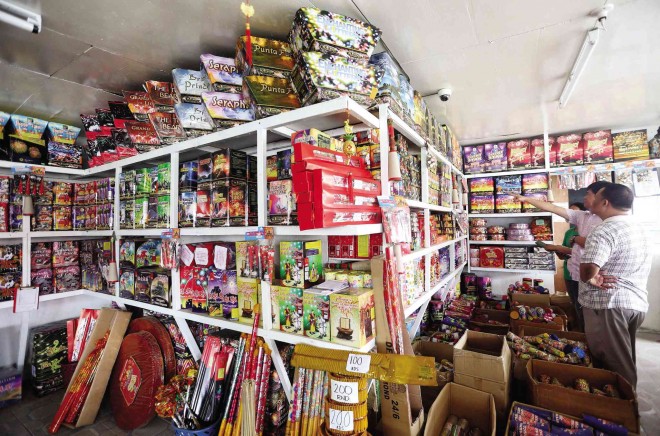MANILA, Philippines—The Department of Health (DOH) is urging local chief executives to ban the use of firecrackers in their respective areas to help prevent accidents and injuries during the New Year revelry.
Acting Health Secretary Janette Garin expressed hope on Sunday that local government units would heed the mounting public clamor for a ban on firecrackers.
“Mayors and governors are being called to join in the campaign to eliminate firecracker injuries … Their participation is vital in the success of our campaign against firecrackers,” Garin said in a statement.
At present, only the cities of Baguio, Olongapo, Davao, Kidapawan, Zamboanga and Muntinlupa ban the use of firecrackers during the New Year merrymaking.
DOH records show that yearly, Metro Manila has the biggest number of firecracker-related injuries, followed by northern Mindanao, Davao region and Western Visayas.
In the National Capital Region, the cities of Manila, Pasig, Las Piñas and Pasay have the highest number of firecracker accidents and injuries annually.
As of Sunday morning, three days ahead of the New Year, the DOH had already monitored 130 firecracker injuries across the country, which was 42 percent or 93 cases less than the numbers in 2013.
Of the total number of injuries, 129 were caused by firecrackers. One was by firecracker ingestion by a 5-year-old boy from San Mateo, Rizal, who mistook a piece of “luces” (sparkler) for a candy, the DOH report said.
Nearly half of the cases were in Metro Manila, with 22 injuries reported in Manila. At least 12 cases were reported in northern Luzon.
Piccolo, a small and colorful firecracker that has been banned in the market, was still the No. 1 culprit, accounting for 86 cases.
At least six firecracker-related injuries were caused by “five-star,” five cases were due to “camara” and five cases due to “boga.”
Of the 130 cases, six people lost their hands in firecracker explosions while 25 people sustained eye injuries, said the report.
While there has been no death so far from the holiday revelry, the Philippine National Police (PNP) has recorded a total of 31 injured persons over the past two weeks.
Most of the injuries were firecracker-related, while the rest were either due to illegal discharge of firearms or stray bullets, data from the PNP public information office showed.
The PNP has been monitoring casualties, arrests and confiscated items as part of its “Ligtas Paskuhan (Safe Christmas) 2014.”
Of the 31 victims, 21 were firecracker-related injuries, six were due to stray bullets, while four were due to illegal discharge of firearms or indiscriminate firing.
The PNP spokesperson, Chief Supt. Wilben Mayor, said nine incidents of illegal discharge of firearms were reported in Metro Manila, Ilocos, Central Luzon, Calabarzon, Zamboanga and the Autonomous Region in Muslim Mindanao.
Earlier, the PNP sealed the service firearms of its policemen with tape, signed by commanding officials as a traditional, preventive measure against indiscriminate firing.
Policemen and civilians are constantly warned against firing their guns during the holiday revelry, which in the past years caused the death of innocent bystanders.
In late 2012, a young girl, Stephanie Nicole Ella, was hit by a stray bullet as she was watching a fireworks display in her neighborhood in Caloocan City. She died in early 2013.
So far, the PNP has confiscated a total of 1,100 pieces of illegal firecrackers worth P8,000—mostly “Good-bye Philippines,” a banned firecracker—according to Mayor.
However, no one has been arrested for selling or possessing illegal firecrackers.
The PNP will conduct on Monday an ocular inspection of stores selling firecrackers and pyrotechnic devices in certain cities in Bulacan, which is famous for manufacturing the products.
The Bureau of Fire Protection (BFP) reminded merchants selling firecrackers and pyrotechnic devices to have fire extinguishers, water and sand ready in case of fire as the New Year approaches.
The BFP issued the warning particularly to traders in Bocaue, Bulacan, the country’s firecracker capital, as buyers are expected to flock there to buy firecrackers for the revelry on Dec. 31.
BFP officer in charge Chief Supt. Ariel Barayuga said sellers must always have four fire extinguishers, a drum of water and half a sack of sand to help put out a fire just in case.
The agency has recorded six fire incidents caused by firecrackers or pyrotechnics since the start of the month.
“It has been the practice of Filipinos to welcome the New Year with much merriment and revelry. Firecrackers and pyrotechnics are commonly used in the celebration. The BFP wants to ensure a fire-free New Year,” he said.
The BFP conducted an inspection of firecracker stores in Bocaue over the weekend as part of its “Oplan Paalala 2014: Iwas Paputok, Sakuna at Sunog.”
The BFP held the inspection with the PNP, which oversees the sale of explosives through the Firearms and Explosives Office.
Barayuga said the inspection went smoothly although some traders hid their illegal firecrackers during the inspection but brought them out after the inspectors had left.
The BFP was able to seize some illegal firecrackers to prevent their sale and distribution, while establishments with excess stocks of firecrackers were advised to reduce their products to avoid accidents.
Barayuga also urged the public not to use firecrackers during the merrymaking to avoid injury, air pollution and fire during the New Year.
But if one could not resist, the BFP said the public must buy only legal and regulated firecrackers.
The law prescribes that firecrackers that have more than 0.2 grams or 1/3 teaspoon in explosive content, oversized firecrackers or those with short fuses are considered banned.
RELATED STORIES
30 firecracker injuries already recorded from Dec. 21 to morning of Dec. 25—DOH
Department of Health airs concern over firecracker injuries
